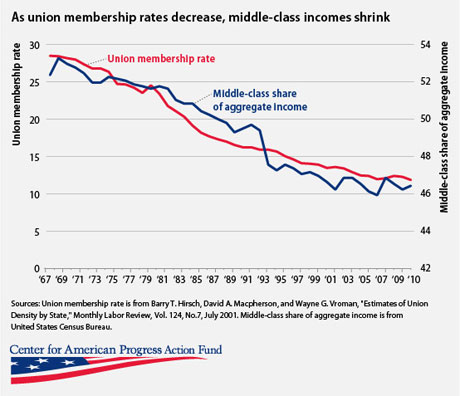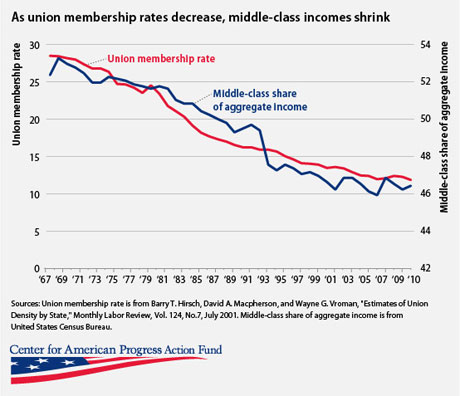
The middle class received close to the smallest share of the nation’s income it ever has since this data was first collected, according to Census data released today. In 2010, the middle 60 percent of all Americans garnered only 46 percent of the nation’s income, down from highs of around 53 percent in 1968.
The middle class weakened over the past several decades because the rich secured the lion’s share of the economy’s gains, with the share of income for the top fifth increasing by 6 percentage points from 1979 to 2010 according to Census Bureau data.
And the richest of the rich have done even better. The share of pretax income earned by the richest 1 percent of Americans more than doubled between 1974 and 2007, climbing to 23 percent from 9 percent, according to research by economists Thomas Piketty and Emmanuel Saez.
In contrast, incomes for most Americans were nearly flat over this same time period, and median income after accounting for inflation actually fell for working-age householdsduring the supposedly good economy in the recovery between 2001 and 2007. As a result, the share of income going to the middle class has declined over the past 40 years.
In 2010, the middle class saw a very slight increase of 0.2 percent in their income share, but this very slight improvement is likely only temporary. During down economies the relative position of the middle class tends to temporarily improve because the income of the wealthy is more variable and drops further. Sadly these blips are quickly reversed once the economy gets going, and thus the decline of the middle class is likely to continue, as it has for decades.
There are many reasons for the dramatic weakening of the middle class, including technology, trade, and increasing returns to education. But a key—though too often overlooked—explanation is the decline in the percentage of the workforce that is unionized.
The figure below shows that the percentage of unionized workers tracks very closely with the share of the nation’s income going to the middle class—those in the middle three-fifths of income earners. As the percentage of workers in unions has declined, so has the middle class.
Membership in private-sector unions stands at less than 7 percent today, down from around 30 percent in the late 1960s. Public-sector unionization remained stable for decades—it was 37 percent in 1979 and is 36 percent today—but is now under significant threat from conservative political opposition and could start declining as well. All told, less than 12 percent of the total workforce is unionized, and this percentage is likely to continue falling.
Unions make the middle class by ensuring that workers have a strong voice in both the market and in our democracy, as described in detail in a Center for American ProgressAction Fund report. When unions are strong they are able to ensure that workers are paid fair wages, receive the training they need to advance to the middle class, and are considered in corporate decision-making processes. Unions also promote political participation among all Americans, and help workers secure government policies that support the middle class, such as Social Security, family leave, and the minimum wage.
But as unions have become weaker over the past four decades, they are less and less able to perform these functions—and the middle class withered. Without the counterbalance of workers united together in unions, the middle class shrinks because the economy and politics tend to be dominated by the rich and powerful, which in turn leads to an even greater flow of money in our economy to the top of income scale.
In short, in order to rebuild America’s middle class, we need to rebuild the labor movement.
Join us in defending the truth before it’s too late
The future of independent journalism is uncertain, and the consequences of losing it are too grave to ignore. To ensure Truthout remains safe, strong, and free, we need to raise $43,000 in the next 6 days. Every dollar raised goes directly toward the costs of producing news you can trust.
Please give what you can — because by supporting us with a tax-deductible donation, you’re not just preserving a source of news, you’re helping to safeguard what’s left of our democracy.
 Click here to view larger.
Click here to view larger.